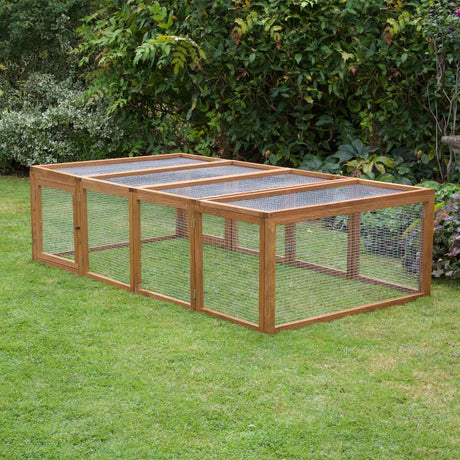It might surprise you to learn that some rabbit owners consider rabbit hutches a form of animal cruelty. But in some cases these owners may be right.
Like all animals, pet rabbits require a certain amount of housing for living. If their environment is too small, all pets can suffer mentally and physically.
They should also have daily access to an exercise area. Both of these areas should be well-built, weatherproofed, and secure against predators.
Any housing that doesn’t provide these minimums is indeed cruel. And it would be negligent to expect your bunny to live in a small hutch 24/7.
However, even though we all agree that a hutch is not enough, it’s not a negative in and of itself. In fact, a hutch can be an essential component of your rabbit palace.
Are Rabbit Hutches Cruel?
According to the animal welfare organization the Rabbit Welfare Association and Fund (RWAF), a hutch should have, at minimum:
- Space for a rabbit to stand up on hind legs without its ears touching the ceiling
- Horizontal room to hop three times from end to end
- Room enough to stretch out on the floor without touching the sides

This is true whether your pet is large, small, or average sized. The size your hutch can vary, just like the size of your rabbits. But these minimum principles are non-negotiable.
And if you have multiple rabbits, the Rabbit Welfare Association (RWAF) agrees that you should give them more room to live.
But this is just for starters. A hutch is your rabbit’s living area. Think of it like a teenager’s bedroom. The hutch should have everything your pet rabbits need, including:
- A hide or bunny box
- At least one litter box
- Food dishes
- Water dishes or bottles
- Toys and boredom busters
At the same time, just as you wouldn’t want your child to spend all their time in their room, your bunny also needs regular time outside of its house to run, jump and dig. It's basic animal welfare -- that is, rabbit welfare.
In addition to the largest hutch you can afford, your rabbit palace will need a spacious run.
Our hutches and runs work together to provide a safe combined living and exercise space for your pets. They’re well-built with sturdy wood and chew-resistant wire. In addition, we have numerous weatherproofing options for both hutches and runs. Weatherproofing can protect your bunnies and extend the life of your hutch by years.
You can connect our hutches and runs to provide all-day access to both, so that your pet rabbits can rest and run about on their own schedule.
And at night, simply return your pet rabbits to their hutch and lock the connecting door to keep them safe and sound.
How Long Can You Leave a Rabbit in a Hutch?
This is a more complicated question than you might think.
First, rabbits are social. This means that they want to be part of your family life. It’s possible to keep a solo rabbit, but loneliness can take a toll on their mental and physical health.
Bored, lonely rabbits may become destructive. Your pet may also become aggressive. And stress plays a role in any number of animal ailments, including GI stasis.
If you’re keeping a single bunny, make sure to visit with them every single day. If possible, owners should place the enclosure in an area of the home or garden where people gather regularly.
And don’t leave them in their hutch for more than a regular working day.
How long can you leave a pair of rabbits in a hutch?
If you have more than one rabbit, they can keep one another company. They can play with each other, groom one another, and entertain each other, too.
But domestic rabbits aren’t as independent as wild rabbits. Your domestic rabbits crave human companionship, too, not to mention exercise and mental stimulation.
Don’t leave a pair of rabbits in their hutch for more than 24 hours.

If you’re going to be away, have a friend visit with your bunnies at least once a day. Your rabbit sitter should also:
- Check food and water levels daily
- Inspect your rabbits for signs of illness or injury
- Let your bunnies into their run every single day
- Play with your rabbits, especially if you have a single bun
- Install a rain cover and/or run shade if inclement weather is predicted
A Hutch Alone Is Not Enough
But it is a start.
A hutch provides living space. It should have enough room for your rabbits to eat, use the toilet, and stretch out to rest. A hutch can keep your rabbits safe at night, too. And if you equip it with toys and boredom busters, it can be a very nice place to hang out, indeed.
But a hutch is only the beginning.
Rabbits, like all animals, need to move. In the wild, a rabbit may roam up to three miles in a day! So provide your rabbit with regular access to a spacious run or other area. You can also set up an indoor bunny gym using a puppy pen.
In fact, you can combine playtime and social time by setting up a puppy pen inside your house, whenever your family gathers to play games or watch TV.
So, are hutches a bad thing?
If your rabbit is left alone inside all day, with no playtime or socialization, then yes, absolutely.
But your hutch can also be the foundation of a larger enclosure that can keep your rabbits not only safe, but also happy, healthy, and well entertained.








